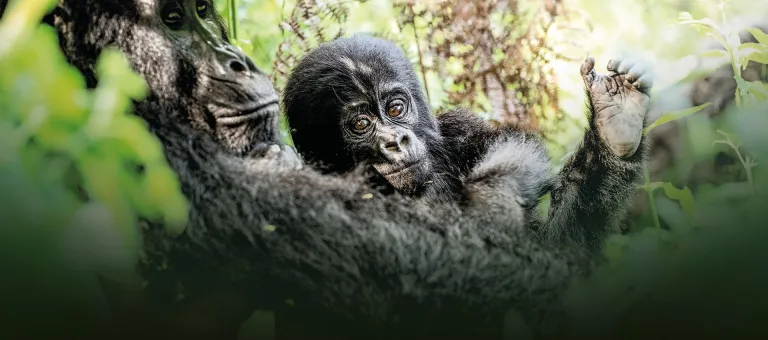The Bwindi Impenetrable Forest National Park in south-west Uganda is home to almost half of the world's remaining mountain gorillas. The small habitat of these friendly apes, which are so closely related to us, is completely surrounded by cultivated land. Fields and tea plantations, villages and roads - but above all a rapidly growing population - exert enormous pressure on the mountain rainforest and all the animals and plants living in it. Although "gorilla" tourism creates worldwide attention for the endangered animals and is also an important economic factor for the country, the mountain gorillas cannot survive in the long term if the people in the direct neighbourhood of the mountain gorillas do not feel any benefits - or even experience disadvantages. We would like to introduce you to a project that addresses precisely this issue, supports local village communities and provides sustainable help.
We have been walking for over an hour on increasingly narrow paths, sometimes through dense undergrowth, in the damp and dense rainforest. The sun rises higher and higher. During the first break, we take off our jackets, and in the second break that follows shortly afterwards, some of us need several minutes to catch our breath. We are at an altitude of over 2,200 metres and our path is either steeply uphill or slippery downhill. It has rained during the night. At the third break, the first people ask themselves why they are actually doing this. But the slog has a good reason, which we suddenly see in front of us: Mountain gorillas!
A story of water and trees
Text by Andreas Klotz, photos by Michael A. Winter and Andreas KlotzWe visit the Bitukura gorilla family in the Bwindi Impenetrable Forest National Park - and it really does almost feel like a family visit.
Protecting the last mountain gorillas in Uganda
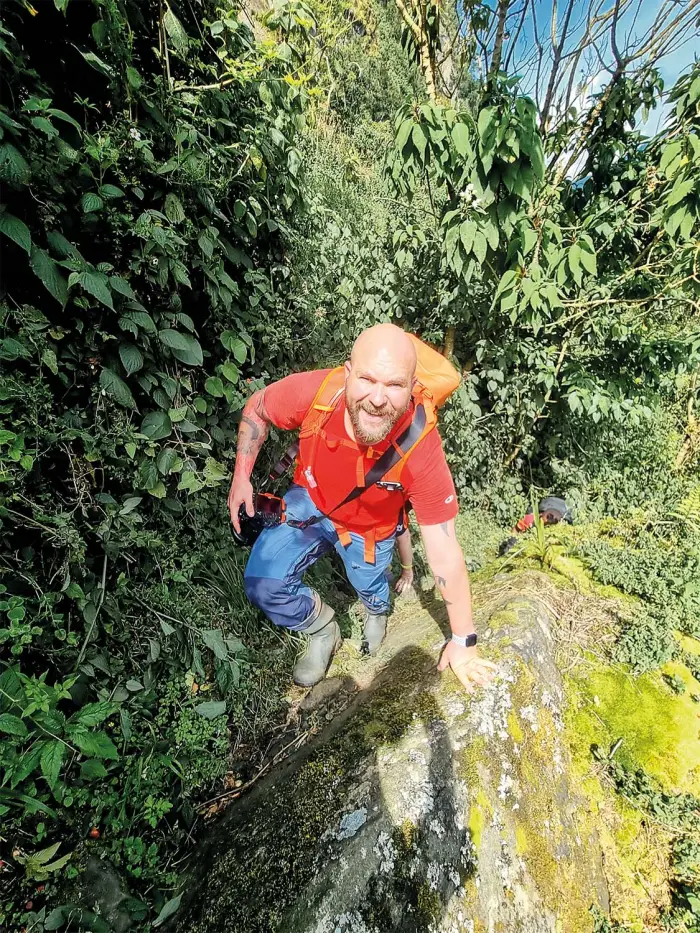
Michael Winter climbing up the mountain (Photo: Andreas Klotz)
Emotional encounter for the first time
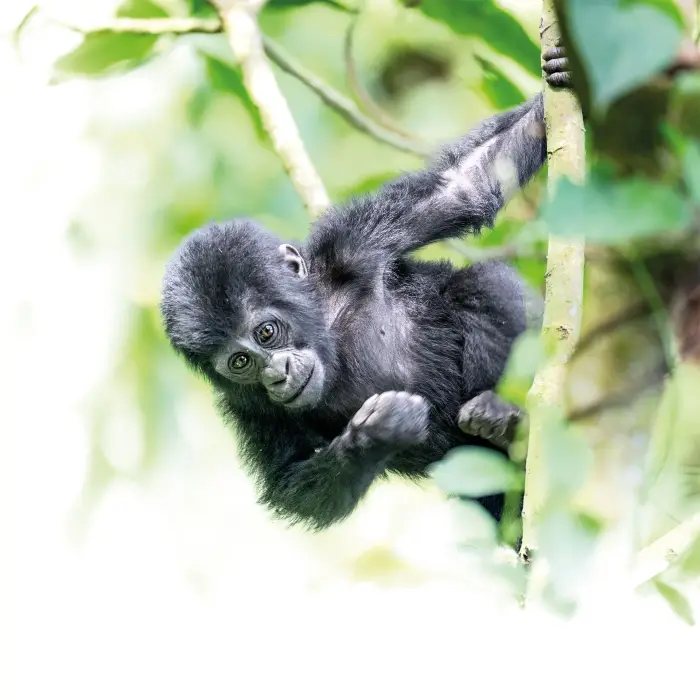
Mountain gorilla baby (Photo: Michael Winter)
Like the vast majority of tourists, this is the main reason we travelled to Uganda - and we are not disappointed. We visit the Bitukura gorilla family in the Bwindi Impenetrable Forest National Park - and it really does almost feel like a family visit. Along with the mighty Siberian Mugisha, 12 other mountain gorillas live here. Rukumu is an old male gorilla who continues to hike with the group as a "pensioner". Betina and Thursday are two of the four adult females. Kakuto is a boisterous male teenager and there has been a very young baby for a few months. We learn a lot about these gentle giants, who are so closely related to us, from our local companions ... while we watch them go about their daily business.
We are only allowed to stay with them for an hour. A period of time that flies by and yet holds countless wonderful moments: A mother lovingly suckling her young ... Kakuto chewing on twigs the whole time and persistently plucking off leaves ... two young animals wrestling loudly with each other ... but the most emotional moments are the clear gazes with which they also watch us intensely.
We are only allowed to stay with them for an hour. A period of time that flies by and yet holds countless wonderful moments: A mother lovingly suckling her young ... Kakuto chewing on twigs the whole time and persistently plucking off leaves ... two young animals wrestling loudly with each other ... but the most emotional moments are the clear gazes with which they also watch us intensely.
Gorilla research and much more
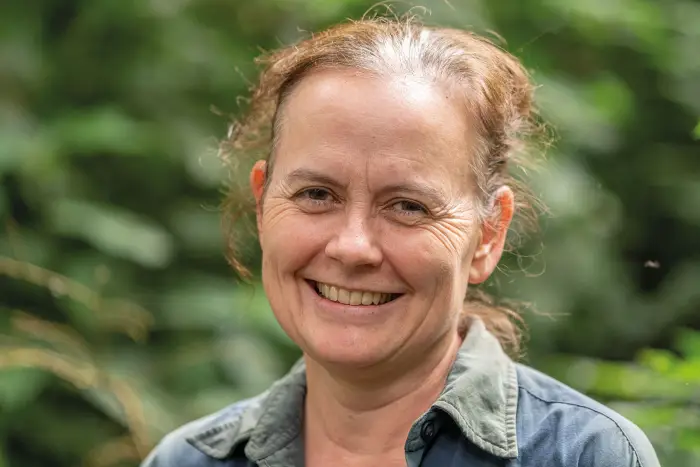
Dr Martha Robbins (Photo: Andreas Klotz)
We are travelling to Uganda together for the second time and are accompanied by Dr Martha Robbins. She is a research associate at the Max Planck Institute for Evolutionary Anthropology in Leipzig and head of the Bwindi gorilla project. The dedicated American scientist and her team have been researching and protecting mountain gorillas for 25 years.
Since 1998, she has also seen supporting and educating the local population around the national park as part of her mission and has been involved in many local community projects. She has been supported by Mondberge since 2009 - and by the proWIN pro nature foundation since 2021.
Since 1998, she has also seen supporting and educating the local population around the national park as part of her mission and has been involved in many local community projects. She has been supported by Mondberge since 2009 - and by the proWIN pro nature foundation since 2021.
Helping people to help themselves
We came back not only to see the gorillas, but also to inaugurate a new charity project. Unimaginable for most people here, it is quite normal for children (mostly girls) to have to walk for up to an hour twice a day - in the morning before school and again in the afternoon - with a 20-litre jerry can to fetch water for the family. Most of the houses have neither running water nor electricity. Matthias, a member of Martha's team, came to her one day with the idea of building a water pipe that doesn't need electricity, but works solely by gravity and natural gradients. He comes from here and lives with his wife and young son in one of these villages, right on the edge of the national park. The whole community, from teenagers to village elders, wanted to help. Labour, know-how and motivation were available, what was missing was simply "only" enough money to procure the necessary materials for the construction.

"Helping people to help themselves" couldn't work any better, we thought when we heard about it and pledged our support in 2021. When the pandemic was finally over and the planning phase was completed, we were able to get started at the end of 2022. The construction work only took five months because hundreds of volunteers really got stuck in. The result was a water pipeline almost four kilometres long, laid underground, which draws water from two underground springs, passes it through several intermediate tanks to build up pressure again and again - and ultimately provides fresh water around the clock at six standpipes near the homes of around 4,000 people. All that is needed is to turn on a tap - an experience for everyone there and an almost unimaginable improvement in life for so many. And above all: this water pipe also helps with the children's education, as they can now come to school more rested and learn much better.
Emotional encounter for the second time
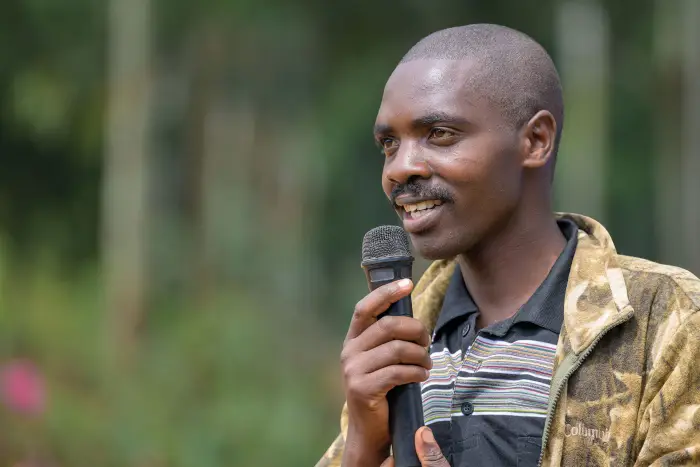
Presenters lead through the ceremony (Photo: Andreas Klotz)
The afternoon after the emotional gorilla tracking, an even more emotional celebration awaited us, the likes of which we had never experienced before. At least 500 people had gathered in a large square near the school, right next to one of the new taps. We were sent an agenda in advance via WhatsApp: 29 (!) items on the agenda, including five dance groups, a theatre play and speeches from pretty much everyone involved in the project - from pupils, teachers, the village elder and the chairwoman of the women's group to various politicians, dignitaries and, finally, Matthias, Martha and Michael.
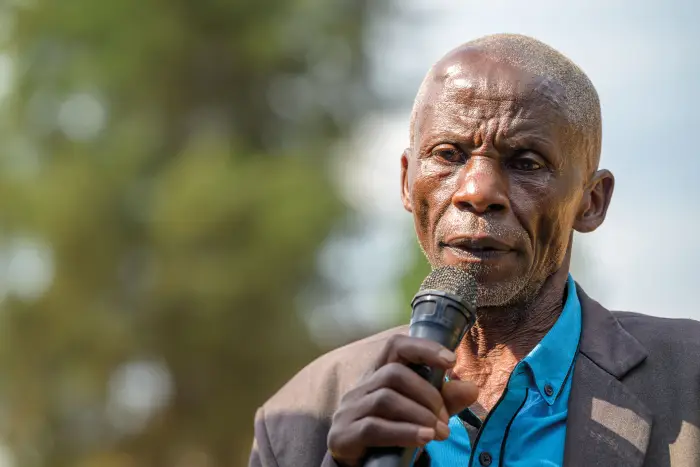
Emotional speech during the ceremonial opening of the water gravity system (Photo: Andreas Klotz)
We were warmly welcomed with singing and dancing and led to our seats under a shady plastic tarpaulin roof, where around 50 other invited guests were already seated. Plenty of drinks were provided, perhaps some of them knew (we didn't) that the ceremony would last four hours. A team of presenters led through the ceremony, speeches in Luganda were translated into English and vice versa so that everyone could understand everything. A DJ provided music and entertainment during the breaks.
The undisputed highlights were the ceremonial opening of the water gravity system with the cutting of a colourful ribbon including the turning on of the tap at the standpipe and the mutual handing over of gifts, such as honey, banana schnapps, eggs and live chickens (which we unfortunately couldn't take home with us).
The undisputed highlights were the ceremonial opening of the water gravity system with the cutting of a colourful ribbon including the turning on of the tap at the standpipe and the mutual handing over of gifts, such as honey, banana schnapps, eggs and live chickens (which we unfortunately couldn't take home with us).
Tree network
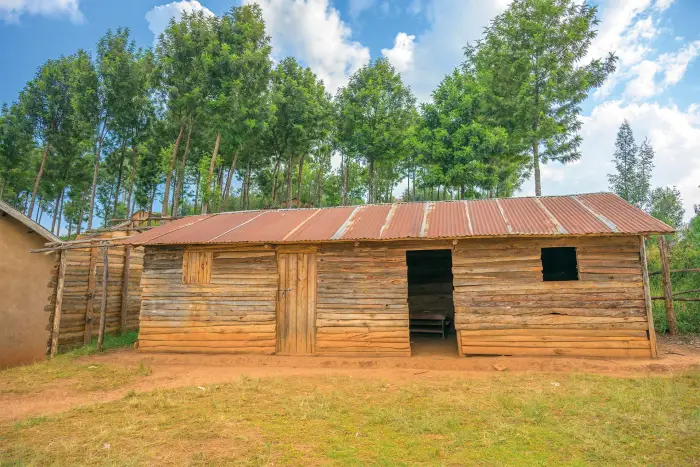
Wooden building (Photo: Andreas Klotz)
Since 2009, tree seedlings of fast-growing conifers have been grown from seed in the schools supported by Mondberge. These small school projects have already resulted in around 8,000 trees being planted each year on school grounds and on public and private land in the community. This year, the first trees have already been felled, from which a school building was constructed and school furniture made.
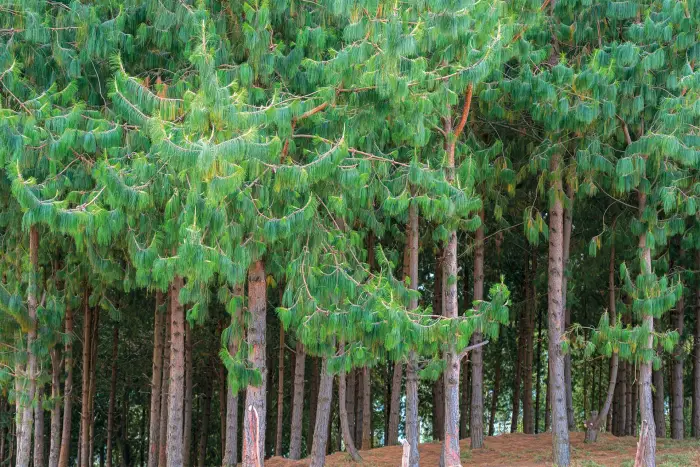
Fast-growing conifers (Photo: Andreas Klotz)
The next day, we were not only able to visit various schools and plant trees ourselves, but also visit a new tree nursery where several hundred thousand seedlings are grown every year, which are then distributed free of charge to the people as part of the Moon Mountains Tree Network. And that's not all: they also receive various indigenous tree species that can be used for medicinal purposes and improve biodiversity in the region.
Lemons, apples and more
Last but not least, we also buy fruit trees. Lemons are an absolute hit, but apples and avocados should also help to improve the families' diet in the future and open up sources of income by selling the fruit.
All of these measures help the local people to help themselves. They help to ensure that they no longer have to search for food, medicine or wood in the national park. This protects the habitat of the mountain gorillas and all other animals and plants living there.
All of these measures help the local people to help themselves. They help to ensure that they no longer have to search for food, medicine or wood in the national park. This protects the habitat of the mountain gorillas and all other animals and plants living there.
The water gravity system...
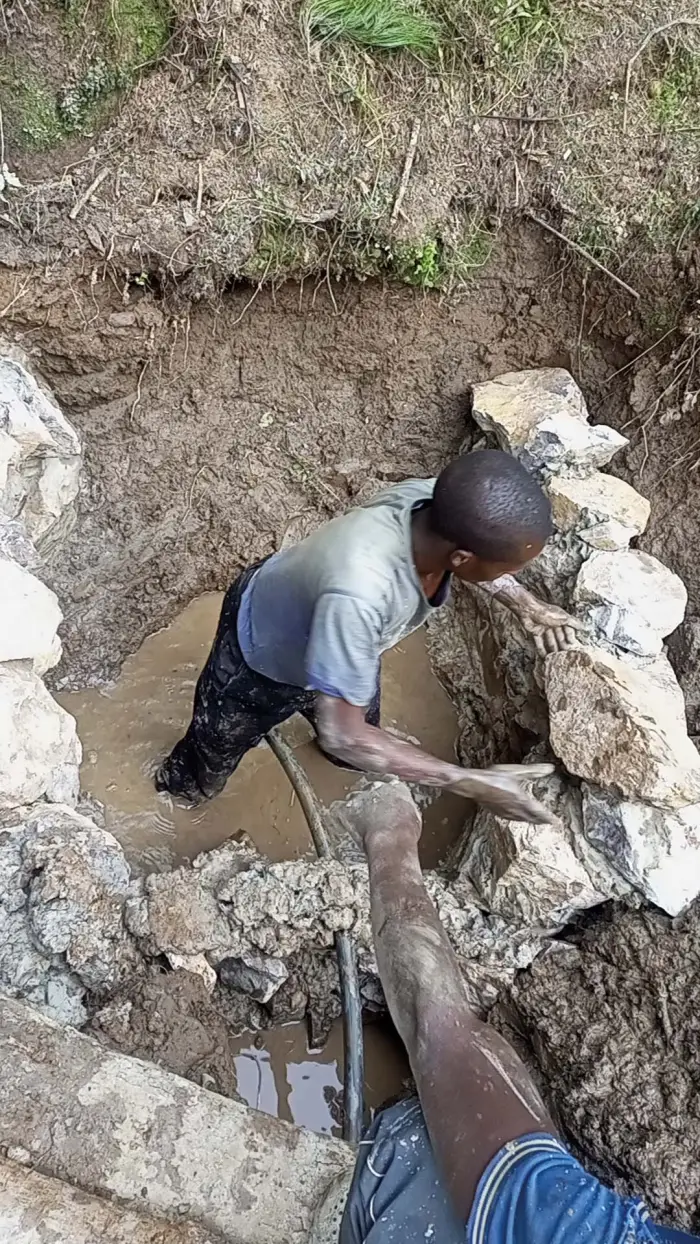
Construction phase (Photo: Andreas Klotz)
... is a joint initiative of the Bwindi Gorilla Project of the Max Planck Institute for Evolutionary Anthropology, Mountains of the Moon, the Ruhija village community and the proWIN pro nature foundation. Around 450 households now have easier and continuous access to fresh water.
Water is drawn from two springs located close to each other. Several water tanks have been built to create additional pressure in the pipes so that the water can be transported over a distance of around 4 kilometres. The land on which the water sources are located was purchased and transferred to the ownership of the Ruhija community.
The pipes were laid about one metre underground and run through the land of 40 landowners. All of them were prepared to make this available free of charge and sign a corresponding agreement, no doubt because they and their families benefit from it themselves. Compensation was paid in some cases, for example when trees had to be felled.
The entire system comprises six water taps in three villages (Mburameizi, Buzaniro and Bitanwa). All community members have free access to all taps. There is no limit on how much water can be drawn, but each household pays an annual maintenance contribution of 1,500 Ugandan shillings (about 38 cents).
Water is drawn from two springs located close to each other. Several water tanks have been built to create additional pressure in the pipes so that the water can be transported over a distance of around 4 kilometres. The land on which the water sources are located was purchased and transferred to the ownership of the Ruhija community.
The pipes were laid about one metre underground and run through the land of 40 landowners. All of them were prepared to make this available free of charge and sign a corresponding agreement, no doubt because they and their families benefit from it themselves. Compensation was paid in some cases, for example when trees had to be felled.
The entire system comprises six water taps in three villages (Mburameizi, Buzaniro and Bitanwa). All community members have free access to all taps. There is no limit on how much water can be drawn, but each household pays an annual maintenance contribution of 1,500 Ugandan shillings (about 38 cents).
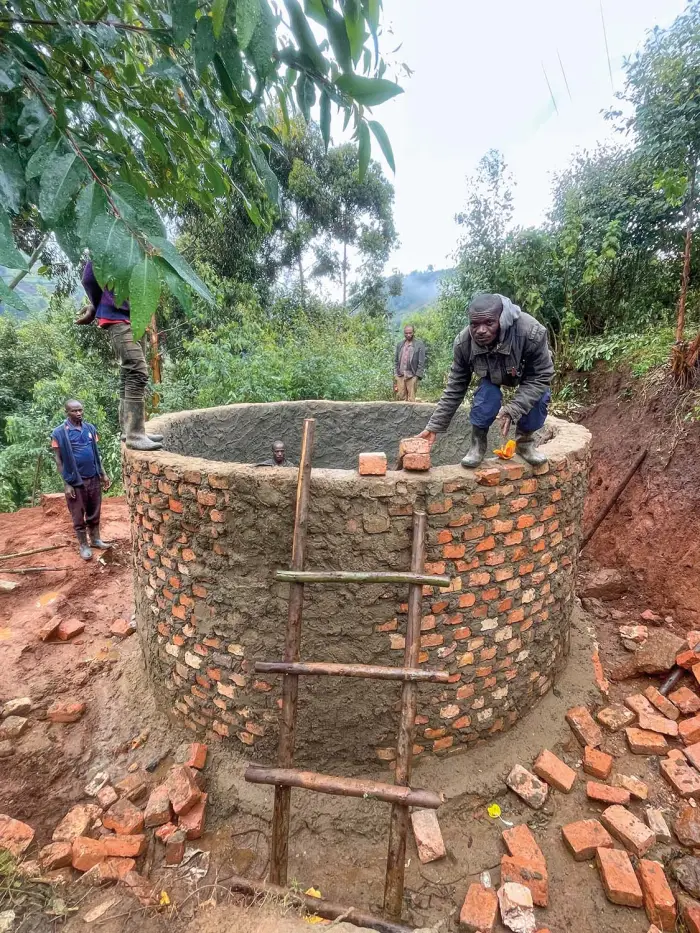
Construction phase (Photo: Andreas Klotz)
All the required materials such as bricks, sand, stones, cement, pipes, fences etc. were purchased locally. The construction time was five months. The municipality is responsible for management and maintenance. Two types of committees were formed, chosen by the community members: one for each village and an overall committee for all three villages together. There are an equal number of men and women on each committee.
The water tanks are cleaned regularly three times a year. During the first cleanings, a technician trains community members. As soon as the training has been completed, the cleaning is carried out by these community members in order to reduce costs and increase personal responsibility. The technician will only visit if a major problem needs to be fixed. The entire committee is responsible for paying these costs.
All land purchased by the community around the spring and where the reserve pool is located is fenced off to prevent grazing animals or people from damaging the property.
The water tanks are cleaned regularly three times a year. During the first cleanings, a technician trains community members. As soon as the training has been completed, the cleaning is carried out by these community members in order to reduce costs and increase personal responsibility. The technician will only visit if a major problem needs to be fixed. The entire committee is responsible for paying these costs.
All land purchased by the community around the spring and where the reserve pool is located is fenced off to prevent grazing animals or people from damaging the property.
Travelling tip
Uganda's temperate climate makes it suitable for travelling all year round, but the best time for safaris is in the drier and cooler months from July to September. December to February is high season. However, climate change does not stop at Uganda, it can also rain outside the earlier rainy seasons (March to May and September to November) - and vice versa.
Interesting facts about Uganda
- Location
Landlocked equatorial country in East Africa, bordering South Sudan to the north, Kenya to the east, Tanzania and Rwanda to the south and the Democratic Republic of the Congo to the west. - Size
Approximately 241,000 square kilometres, which is about two thirds of the area of Germany. 17 % of this is water. - Population
Approximately 42 million, of which around 50 % are under 15 years old. - Religions
Around 85 % Christians and 12 % Muslims, the small remainder is made up of traditional African religions, non-denominational and other religions. - Capital city
Kampala (approx. 1.5 million inhabitants) - Currency
Ugandan shilling (1 euro = approx. 3,850 UGX) - Climate
Tropical-warm, but significantly cooler and more moderate due to the altitude, neither excessively hot nor cold. - Geography
Savannahs in the north, cultivated land and rainforests in the south-west, characterised by four of the largest lakes in East Africa, including Lake Victoria with the source of the Nile in Jinja. Alpine high mountains in the west up to 5,109 metres (Margherita peak of Mount Stanley in the Rwenzori). The lowest point is Lake Albert, which is still 621 metres above sea level. - Fauna
Only in Uganda do the "Big Seven" live; in addition to the African Big Five (elephant, rhino, buffalo, leopard and lion), there are also chimpanzees and mountain gorillas. The country is also very popular with birdwatchers, as there are said to be over 1,000 different bird species. - The economy
Agriculture not only feeds 90% of the population, but also accounts for 80% of export earnings. Particularly noteworthy among these are tea and coffee, tobacco and cotton, but also honey and vanilla or cut flowers, as well as fish, especially from Lake Victoria (Victoria or Nile perch). The most important other source of income is tourism.
